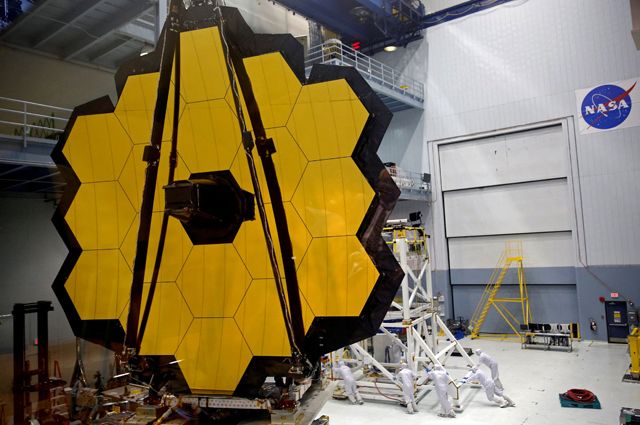
The James Webb Space Telescope (or simply the James Webb Telescope) has been launched from the Kourou Cosmodrome in French Guiana. The most anticipated event in 2021 by astrophysicists has been repeatedly postponed, especially due to bad weather. The orbital infrared observatory, named after NASA's former director, will begin scientific observations six months after launch.
How is it better than Hubble?
The Hubble Space Telescope, which has been in low Earth orbit since 1990, is arguably the greatest achievement of world science and humanity in general. He made many discoveries and took millions of breathtaking images of galaxies and nebulae. But Hubble has exhausted its resources and is technically obsolete. He should be replaced by James Webb. Its development began at the end of the 20th century, and the launch was originally scheduled for 2007, but has been postponed several times. The cost of the project has steadily increased and now stands at around $ 10 billion.
In short, the James Webb Space Telescope (in English, the name is sometimes abbreviated as JWST) & mdash; it is a next generation orbital infrared observatory. It will have to complement and develop the discoveries made by Hubble. In addition, the scientific challenges before Webb were based on the results obtained from Hubble. His achievements and discoveries prompted scientists to use longer wavelengths for observations. The point is that the further away an astronomical object is, the more it has a shift in the red spectrum. And if Hubble studies the Universe primarily at optical and ultraviolet wavelengths, then its changer will observe it in the infrared domain. In general, he will be more perceptive than his predecessor. Main mirror area JWST & mdash; 25 square meters compared to 4.5 at Hubble.
The best Hubble images of all time

Jupiter. This is the first color photograph of the planet Jupiter taken in 1991 with the wide-angle camera of the Space Telescope. © Flickr.com/NASA, ESA and J. Westphal (Caltech)

“Pillars of Creation” in the Eagle Nebula. The objects in the photograph received this name because the gas and dust they contain are involved in the formation of new stars with the simultaneous destruction of clouds under the light of already formed stars. The photo was taken in 1995. © Flickr.com/NASA, ESA, STScI, J. Hester and P. Scowen (Arizona State University)
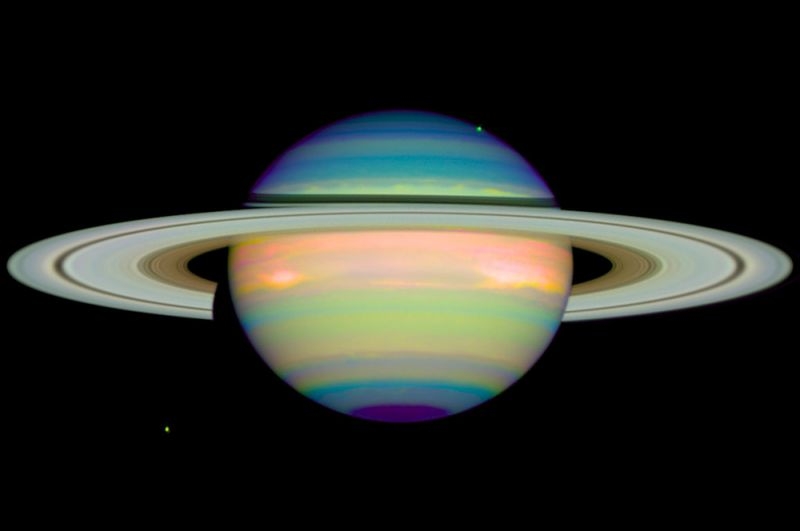
Saturn infrared. The image was taken on January 4, 1998 and shows reflected infrared light from the planet, which gives detailed information about the clouds and haze in Saturn's atmosphere. © Flickr.com/Erich Karkoschka (University of Arizona) and NASA

Jupiter, its moon Io and the shadow of the satellite falling to the surface of the planet. year 1999. © Flickr.com/John Spencer (Lowell Observatory) and NASA

The Horse's Head Nebula in the constellation Orion is one of the most photographed objects in space. The photo was taken in 2001. © Flickr.com/NASA, NOAO, ESA and The Hubble Heritage Team (STScI/AURA); Acknowledgments: K. Noll (Hubble Heritage PI/STScI), C. Luginbuhl (USNO), F. Hamilton (Hubble Heritage/STScI)
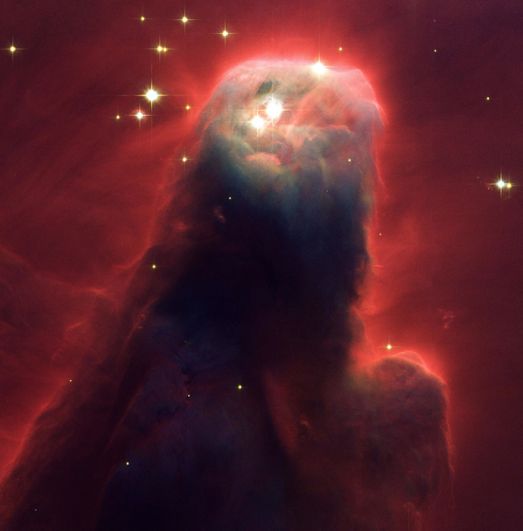
The Cone Nebula. “This object,” writes NASA, “reminiscent of a nightmare beast raising its head from a crimson sea, is actually a harmless column of gas and dust.” Photo was taken in 2002. © Flickr.com/NASA, H. Ford (JHU), G. Illingworth (UCSC/LO), M. Clampin (STScI), G. Hartig (STScI), the team scientist ACS and ESA; The ACS Science Team: H. Ford, G. Illingworth, M. Clampin, G. Hartig, T. Allen, K. Anderson, F. Bartko, N. Benitez, J. Blakeslee, R . Bouwe

The Omega Nebula, 2003. © Flickr.com/NASA, ESA and J. Hester (ASU)

A ring of blue stars around the galaxy AM 0644-741. It is assumed that the ring formed during a collision with another galaxy, while due to gravitational destruction the dust in the galaxy is compacted and forms stars. year 2004. © Flickr.com/NASA, ESA and Hubble Heritage Team (AURA/STScI); Acknowledgments: J. Higdon (Cornell U.) and I. Jordan (STScI)

The Whirlpool galaxy or M 51 in the constellation Canis Hounds. The photo was taken in 2005. © Flickr.com/NASA, ESA, S. Beckwith (STScI) and Hubble Heritage Team (STScI/AURA)

Nebula in the constellation Carina. 2007 year. © Flickr.com/N. Smith (University of California, Berkeley) and NOAO/AURA/NSF

Interacting galaxies. Astronomy textbooks generally present galaxies as lonely, majestic worlds of twinkling stars. But galaxies can be located in space close enough that mutual gravity significantly affects the shape, motion, processes of star formation, and in some cases the exchange of matter between them. . Photos from 2008. © Flickr.com/NASA, ESA, Hubble Heritage (STScI/AURA) -ESA/Hubble Collaboration, and A. Evans (University of Virginia, Charlottesville/NRAO/Stony Brook University)
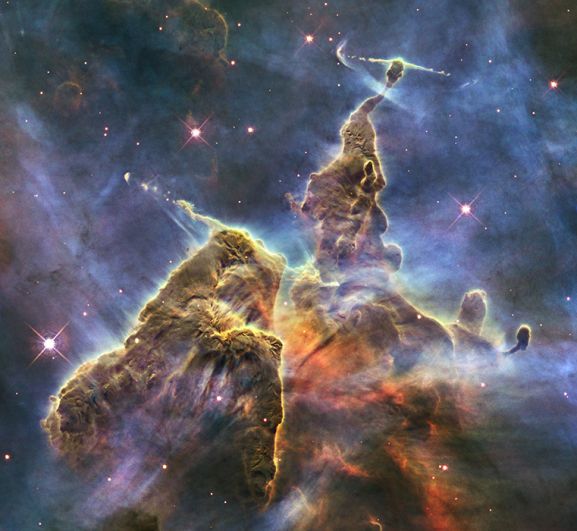
“Mystic Mountain” inside the Carina Nebula. This cosmic peak, three light years high, is made up of dust and gas and shows signs of intense star formation. Snapshot from 2010. © Flickr.com/NASA, ESA and Hubble Heritage Team (STScI/AURA)
The best Hubble images of all time
Jupiter. This is the first color photograph of the planet Jupiter taken in 1991 with the wide-angle camera of the Space Telescope. © Flickr.com/NASA, ESA and J. Westphal (Caltech)

“Pillars of Creation” in the Eagle Nebula. The objects in the photograph received this name because the gas and dust they contain are involved in the formation of new stars with the simultaneous destruction of clouds under the light of already formed stars. The photo was taken in 1995. © Flickr.com/NASA, ESA, STScI, J. Hester and P. Scowen (Arizona State University)

Saturn infrared. The image was taken on January 4, 1998 and shows reflected infrared light from the planet, which gives detailed information about the clouds and haze in Saturn's atmosphere. © Flickr.com/Erich Karkoschka (University of Arizona) and NASA

Jupiter, its moon Io and the shadow of the satellite falling to the surface of the planet. year 1999. © Flickr.com/John Spencer (Lowell Observatory) and NASA

The Horse's Head Nebula in the constellation Orion is one of the most photographed objects in space. The photo was taken in 2001. © Flickr.com/NASA, NOAO, ESA and The Hubble Heritage Team (STScI/AURA); Acknowledgments: K. Noll (Hubble Heritage PI/STScI), C. Luginbuhl (USNO), F. Hamilton (Hubble Heritage/STScI)

The Cone Nebula. “This object,” writes NASA, “reminiscent of a nightmare beast raising its head from a crimson sea, is actually a harmless column of gas and dust.” Photo was taken in 2002. © Flickr.com/NASA, H. Ford (JHU), G. Illingworth (UCSC/LO), M. Clampin (STScI), G. Hartig (STScI), the team scientist ACS and ESA; The ACS Science Team: H. Ford, G. Illingworth, M. Clampin, G. Hartig, T. Allen, K. Anderson, F. Bartko, N. Benitez, J. Blakeslee, R . Bouwe
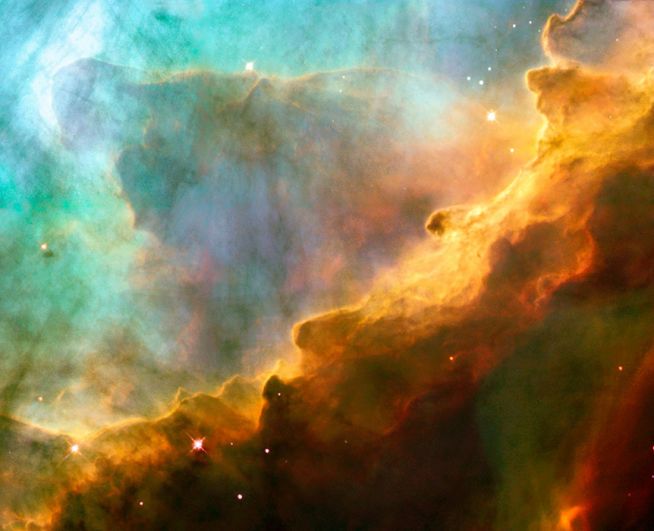
The Omega Nebula, 2003. © Flickr.com/NASA, ESA and J. Hester (ASU)

A ring of blue stars around the galaxy AM 0644-741. It is assumed that the ring formed during a collision with another galaxy, while due to gravitational destruction the dust in the galaxy is compacted and forms stars. year 2004. © Flickr.com/NASA, ESA and Hubble Heritage Team (AURA/STScI); Acknowledgments: J. Higdon (Cornell U.) and I. Jordan (STScI)

Whirlpool Galaxy or M 51 in the constellation Hounds Dogs. The photo was taken in 2005. © Flickr.com/NASA, ESA, S. Beckwith (STScI) and Hubble Heritage Team (STScI/AURA)

Nebula in the constellation Carina. 2007 year. © Flickr.com/N. Smith (University of California, Berkeley) and NOAO/AURA/NSF

Interacting galaxies. Astronomy textbooks generally present galaxies as lonely, majestic worlds of twinkling stars. But galaxies can be located in space close enough that mutual gravity significantly affects the shape, motion, processes of star formation, and in some cases the exchange of matter between them. . Photos from 2008. © Flickr.com/NASA, ESA, the Hubble Heritage (STScI/AURA) -ESA/Hubble Collaboration, and A. Evans (University of Virginia, Charlottesville/NRAO/Stony Brook University)

What is it for?
With the help of James Webb & # 39; s infrared instruments it will be possible to discern, for example, what is under the ice that covers Jupiter & # 39; s moon Europe and Enceladus moon of Saturn. What if there were liquid oceans in waters where unknown life forms live?
The new telescope's equipment will allow it to observe the dust clouds where future stars and planetary systems are currently being born. On the other hand, thanks to its unprecedented sensitivity to infrared radiation, it will be able to “ look into the past '' : observe the light of the first stars and galaxies that appeared shortly after the Big Bang about 13.5 billion years ago.
From James Webb expect a breakthrough in research on exoplanets. He will be able to see celestial bodies comparable to the Earth and located at a distance of 15 light years from us. In addition, he will be able to see their satellites! More than 20 stars closest to the Sun will fall in the area of detailed observations. The orbiting infrared observatory will provide information about the atmospheres of exoplanets and, eventually, even find traces of life there. & Nbsp;
What discoveries are scientists waiting for?
AiF.ru asked experts what discoveries they expect from the new space telescope.
Academician Lev Zelyoniy, scientific director of the Institute for Space Research of the Russian Academy of Sciences :
& mdash; Launch of JWST & mdash; it is not just a long awaited event for science, it is a milestone, the next step in knowing the Universe. Hubble has worked for over 30 years and has dramatically changed the image of the world not only of scientists, but of earthlings in general. I think James Webb will do no less.
The infrared range in which the telescope operates will allow you to look past the clouds of dust that obscure the most 'intimate' ones. places in the Universe: there is the formation of stars and their planetary systems. I am very interested in the results on exoplanets that the JWST will receive: it has serious observational advantages for this.
I wish our colleagues the success they have long deserved. The difficulty does not lie in the launch of the telescope itself (there is no drama in its transfers), but in the fact that now more than 300 critical operations will follow to open the antennas and prepare all the equipment. complex at work. Failure of just one of them will cause the entire project to fail. & Nbsp;
Scientific Director of the Institute of Astronomy of the Russian Academy of Sciences, Corresponding Member of the Russian Academy of Sciences Boris Shustov :
& mdash; JWST project & mdash; very interesting, very ambitious and a record for astronomy. As for my scientific interests, I hope the new telescope will allow me to see the mysterious giant First stars (astronomers call them Population III stars). In fact, the telescope will not record the stars themselves, but the events of their incredibly powerful, but very distant explosions. & Nbsp;
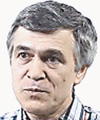
Principal researcher at State Astronomical Institute named after PKSternberg Moscow State University, candidate in physical and mathematical sciences Vladimir Surdin :
& mdash; Hopefully JWST finds something that not many people pay attention to. Namely, the planets flying outside their stars. There must be such a race of planets that have long since left their systems and are wandering the galaxy on their own. They are called rogue planets or rogue planets. It's sort of an insignificant little part of the galaxy, but very interesting, because we don't know anything about them at all. They are not visible in ordinary telescopes because they are not illuminated by the light of the mother star, they are dark. But at the same time, they shine with their heat in the infrared range. And that's exactly the 'Webb' will work in this range and will probably discover many such planets. Then it will become clear how many of them are in the galaxy as a percentage of the planets that stayed with their stars. & Nbsp;
Through these observations, we will, as a first step, be able to understand how our own planetary system formed … After all, we, for example, still don't know where the moon came from. There is a version that a celestial body struck the Earth, and therefore there was a satellite. If we see that there are a lot of rogue planets in the galaxy, this version will be confirmed.
Second, on these planets, oddly enough, life is also possible. Yes, it's dark in there. But in the end it's dark underground and deep in the ocean too, but it has a life of its own.
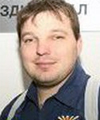
Head of the Astronomical Education Sector of the Moscow Planetarium Alexander Perkhnyak :
& mdash; James Webb telescope a hundred times more powerful, and its instruments 7 times more sensitive than that of the Hubble. But his tasks are slightly different. I would like to believe that his abilities will really allow us to see the young Universe, its first stars and galaxies.
Thanks to this telescope, the study of planets in other stars will reach a new level. We will not only be able to discover new exoplanets, but also to explore their atmospheres. Its accessibility is also encouraging: scientists can submit nominations and use the James Webb telescope; in a variety of research areas for the benefit of science.

